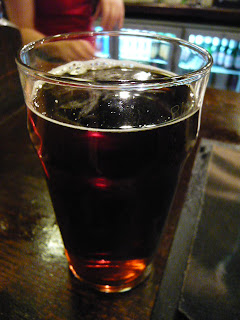8 Broadwick Street
London
W1F 8HN
I chose
The Player for some birthday drinks, and I'm glad I did. Never mind the slightly eccentric decor which makes the place resemble a private airport lounge from the Seventies, I advise everyone to spend a happy few hours in this basement hideaway. The bartenders and waiters were friendly and patient, even when asked to explain exactly how one might go about preparing pressed ginger juice (thanks, Damian) - but the drinks menu is where this place really excels. Just like
Sosho in East London, which I visited just weeks before it was devastated by fire, The Player (which is formally linked to Sosho in a way I haven't quite worked out) distinguishes itself by making proper cocktails.
The drink pictured top is a
Petite Punch, described as the classic cocktail of the French islands. Short and strong, it featured Agricole rum (
Rhum Agricole), which is made from sugar cane juice rather than molasses like most other rums, mixed with cane sugar and about 2/3 of a fresh lime. It was served with a wooden spoon, presumably to stir the sugar, of which there was little evidence. The drink started with sweet lime on the nose, but the rum was rich, packing an intoxicating punch and providing a thick mouthfeel with a long finish.
 Pepino's Gun
Pepino's Gun (right) involved Arette Reposado tequila, muddled with cucumber, fresh apple juice and a splash of fresh lemon. I loved the cucumber (the bartender told me she added two slices to the cocktail shaker before shaking the ingredients with ice), which was subtle but unmistakable. And it reminded me I still haven't gotten around to making a martini with
Hendrick's gin, which demands a similarly audacious cucumber garnish.
Mai Tai: This was Appleton rum shaken with (orange) curacao, fresh lime juice, bitters and orgeat (almond) syrup. I'd never tried one of these before, but being a dedicated experimentalist gave it a go. Well made, but not my favourite.
Penicillin: Scotch whiskies (a mix of Lagavulin and something less peaty) shaken with pressed ginger juice, fresh lemon and honey. The ginger (see above) was pressed with a juicer, or at least I think that's what someone drew on my napkin. Lovely drink.
Rye & Port Cobbler: Pikesville rye whiskey, port, masaschino and fruits. Thankfully, there are still plenty of drinks out there that I've never come across before, and many with the capacity to surprise and delight. This was delicious, although having ordered it towards the end of the evening I might struggle to recall the details.
Blood & Sand: Scotch whisky, cherry liquer, sweet vermouth, orange. Like the Cobbler, this was a new one on me - a bit like a Manhattan, only more interesting. I was lucky enough to try it with
Compass Box Hedonism, a 100% grain whisky - smooth and sweet - which I've since had the pleasure to taste by itself (see future posts).
 Clover Club
Clover Club (pictured left): Tanqueray gin, lemon and raspberries. And egg white (which bars rarely list because of the public squeam about raw things). Although I love the foam produced from a well shaken egg white, there was too much of it in this drink. That said, the gin, lemon and raspberries did their best to balance the creaminess. I must try making this at home.
What drinks! I know it's a small thing, but I'm also grateful to The Player for letting us sit with their little cocktail menus, letting us peruse and debate their contents at leisure, rather than whisking them away from us seconds after taking our order. Drinks geeks, as well as birthday boys, are treated well here.


.jpg)




































